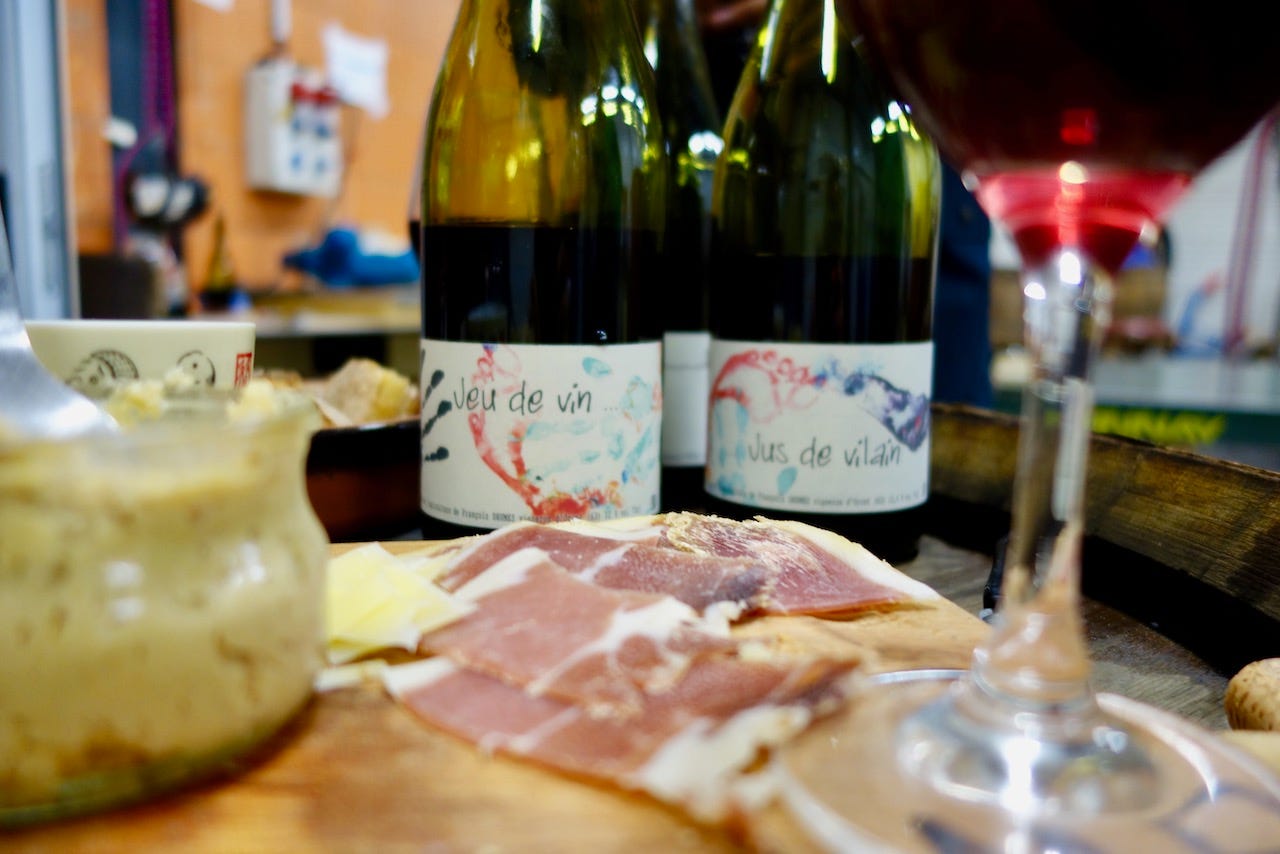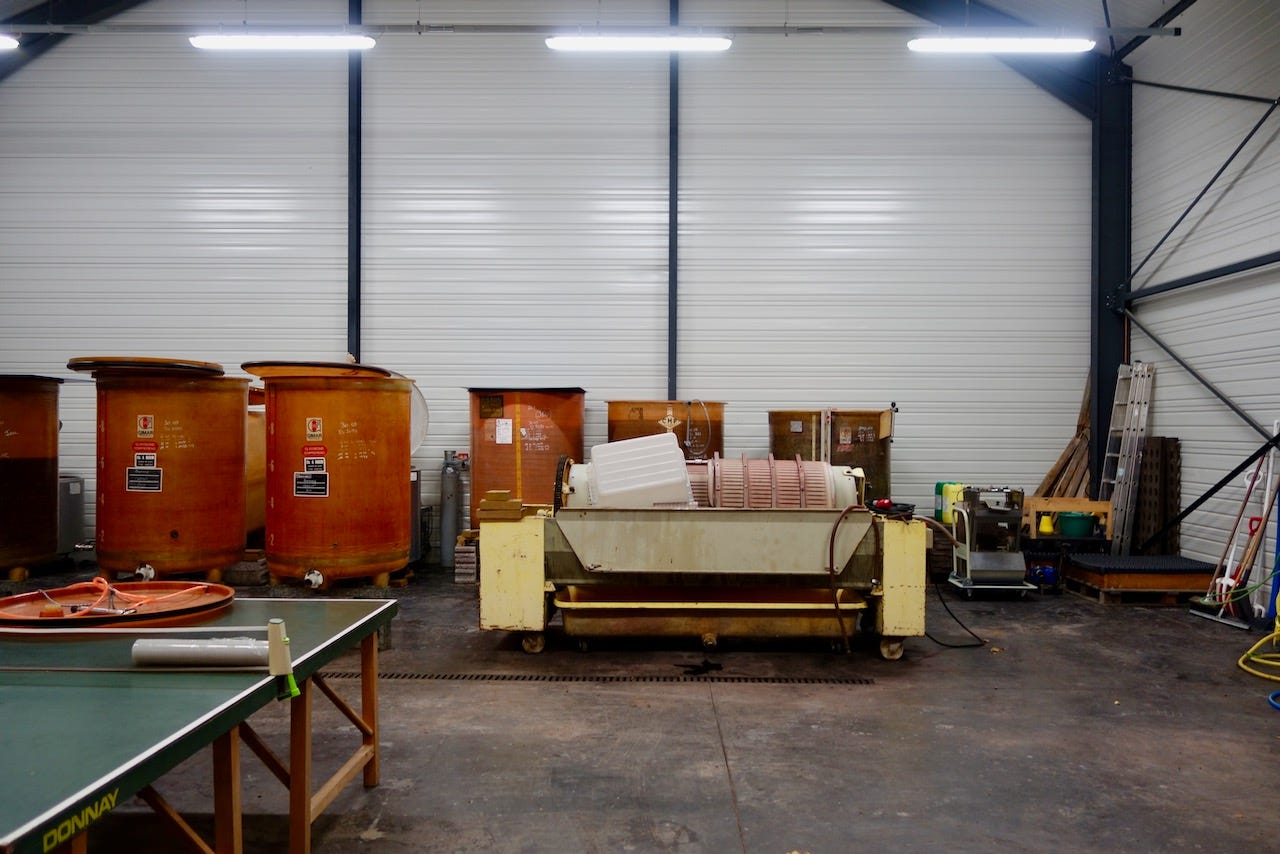AUVERGNE - François Dhumes, Orcet
Among the peculiarities of wine tasting in Auvergne is the distinction made between the native gamay d'Auvergne grape and what many Auvergne winemakers confusingly refer to as "gamay du Beaujolais." By this they mean a variety (presumably clonal) of gamay relatively recently imported from the Beaujolais, and not, as one might infer from the syntax, gamay fruit harvested in the Beaujolais. The distinction between the two gamay variants is rendered particularly stark in the roomy warehouse that functions as the home and cellar of diminutive Orcet-based natural vigneron François Dhumes, who I visited this past November.
"When we say 'gamay du Beaujolais,' people always say, 'Oh, you purchase grapes?'" says Francine, his companion and collaborator. "Now we often just say 'gamay,' because it brings confusion otherwise."
"There are lots of gamays," adds Dhumes, drawing a taste of fermenting wine from a fibreglass tank. "Gamay fréaux, there's gamay blanc, too, but it disappeared."
Dhumes has boyish, Ferris-Bueller features that belie his long experience in winemaking. After working for conventional domaines in the Rhône and the Mâconnais, he returned to his native Auvergne, producing his first wine in 2006 while doing vineyard work for neighboring natural winemakers Vincent & Marie Tricot and Patrick Bouju. Since then has acquired a patchwork of small parcels totalling 4ha in the villages of Corent, Chidrac, and Perrignat-sur-Allier.
Today he produces around eight cuvées, depending on the vintage. There is a pétillant-naturel rosé, a pétillant-naturel white, along with micro-quantities of pinot noir and chardonnay. His most significant work is in gamay, spread across three cuvées: "Jeu de Vin," a gamay d'Auvergne vinified whole-cluster, semi-carbo, without much extraction, aged in tank; "Jeu de Vilain," a gamay du Beaujolais vinified and aged in the same manner; and "Minette," a gamay d'Auvergne vinified in a more Burgundian style, destemmed, with a year of barrel-aging.
I'd tasted previous vintages of these cuvées before, here and there in Paris, at clients of Dhumes' like Le Vin Au Vert, Saturne, Crus et Découvertes, La Cave des Papilles, Chambre Noire. But tasting them together in November was eye-opening, for the study it offered on the characteristics of gamay d'Auvergne.

"Jeu de Vin" and "Jeu de Vilain" are two sides of the same coin. (Their names are a play on the French expression "Jeu de main, jeu de vilain," which translates roughly to, 'horseplay leads to fights.') The 2017 wines share a wholesomeness, a vibrancy - but where "Jeu de Vin" is stolid and forthright, somewhat matte, reminiscent of Hervé Souhaut's work with gamay in Ardèche, "Jeu de Vilain" is as fleet-footed as anything from the crus of the Beaujolais. A clear favourite of Francine's, "Jeu de Vilain" is a surpassingly delicate wine, crystalline, yet retaining a certain endearing foxy bristle. Surprisingly, for such an exemplary, Beaujolais-style "gamay du Beaujoais," the wine derives not from granite terroir, but rather red-clay in Chidrac.
"Minette," named for Dhumes' grandmother, is where his gamay d'Auvergne truly shines. Dhumes ironically refers to it has his "Cuvée Fûts de Chêne," in the manner of countless pitiable supermarket wines. Here, destemming and a longer, juicier maceration with three or four pigéages seem to make the most of gamay d'Auvergne's darker colour and thicker skins. The 2016 wine, while light by most standards, possesses a sap and a savouriness all its own, notes of violet and bramble tracing a graceful arc on the palate. The grapes derive mostly from Perrignat-sur-Allier, where Dhumes' vines are on the vaunted local basalt terroir.
The rest of Dhumes' production is similarly stellar. But here, as elsewhere in Auvergne, quantities are tiny, and generally sold practically before they are released. It is an effect of the moribund state of Auvergnat winemaking as a whole. Two handfuls of savvy free-thinking contrarian winemakers in Auvergne have raised the region's profile in the chic-est wine bars of Paris and the world - but Auvergnat wine production as a whole remains a marginal industry. The local population is practically indifferent to its existence.
"[The region's wine] drags a bad reputation since phylloxera, in fact," Francine observes.
"Especially in the 1960s, [local winegrowers] made the vine piss, because it was for the Michelin workers," says Dhumes. "They drank a lot, because it was hot, and the water wasn’t good. So they drank litres and litres of piquette at 8° alcohol."
Along with his dozen or so other like-minded natural winemaker neighbors, Dhumes is helping write a new chapter in Auvergne winemaking. The 2017 vintage proved a setback, as frost drastically reduced yields across the region. (No "Minettes" was produced in 2017.) Yields in 2018 were comparatively bountiful, as elsewhere in France, although Dhumes' remained rather low at 20HL / ha for pinot and gamay.
Our voices echo in the warehouse, situated at the end of a small industrial estate on the outskirts of Orcet. The main room houses, in addition to almost all his fermenting tanks, a corner devoted to demijohns of vinegar, and a ping-pong table. I observe that he has a lot of room to expand.

"I may have envisioned things a bit too large-scale," he deadpans. "But at least when I leave here, the site won't be of interest only to winemakers."
François Dhumes 17, rue de Bourdelas 63670 ORCET
[youtube https://www.youtube.com/watch?v=d2pw-QAzGZY?start=73]
Related Links
Bert Celce's beautiful 2010 piece on François Dhumes at Wine Terroirs. A stub of a profile on François Dhumes at Entre Les Vignes. Photos of a 2012 visit to François Dhumes at the site of his UK importer, Gergovie Wines.


